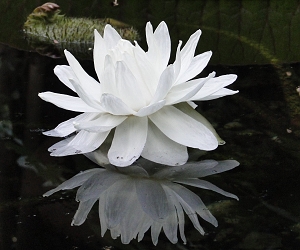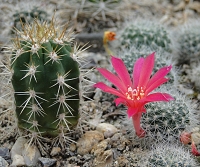Botanical Garden
Charles University Science Faculty
Greenhouse collections
The greenhouses underwent complete reconstruction in 1997–2000, which increased their area to 2000 m2, including a dedicated exhibition area of 1600 square meters, with the remainder used for plant cultivation and technical purposes. It is divided into tropical and subtropical areas.

Tropical greenhouses
The central entrance area with the highest domed roof is devoted mainly to cycads and, more recently, palms. The most notable of the cycads are the massive specimens of the Southeast Asian species Cycas circinalis, over 150 years old. There are also other examples of cycads such as the south Japanese Cycas revoluta, a representative of the African Encephalarthos genus or American species of the Zamia genus; Cycads are mostly dioecious plants, so they are usually represented only by one sex – mostly male specimens with huge cones. In the rear of this building is an attractive new collection of more species of young palms, with both pinnate and palmate leaves. The remaining space is filled with more well-known kinds of Dracaena and massive plants from the knotweed family, especially the large-leaved Coccoloba, which today is often grown as a feature in the interior of premises of large companies and hotels.
The largest area in another part of the greenhouse is dedicated to tropical forest plants, especially paleotropical flora. There are many herbs, mainly from the Araceae family. Particularly illustrative of the diversity of ferns is a collection of tropical ferns, located on the left of the path as you enter the tropical area. There you will find a wide range of terrestrial ferns (e.g. from the Polypodium, Asplenium and Blechnum genera) and epiphyte ferns of the polypod family (Phlebodium, Platycerium, Drynaria), interesting because of their frond dimorphism.
The evolutionary (phylogenetic) aspects of tree ferns from the Cyatheaceae family are very interesting. Currently represented here only by younger specimens, they grow to a height of several meters. Other evolutionarily interesting examples are the eusporangiate ferns of tropical Asia. One, Angiopteris evecta from the Marattia family (Marattiaceae), the only eusporangiate fern native to tropical Asia, is especially interesting. On the opposite side towards the pond, in addition to finding some typical commercial tree species such as coffee (Coffea arabica) and papaya (Carica papaya), there are larger numbers of species of the acanthus family (Acanthaceae) with richly flowering inflorescences with colored bracts (some of which e.g. Pachystachys – lollipop plant – bloom most of the year).
The middle third of the tropical greenhouse is a pond with ornamental cultivars of water lilies, annually restocked with Santa Cruz water lily (Victoria cruziana), which also belongs to the water lily family. It is known for its large round thorny plate-shaped leaves and a large flower which blooms for only two nights. From the botanical point of view, however, the pond contains an interesting fern example – the massive Acrostichum aureum from tropical Asia, characteristic of the coastal mangrove vegetation, or, popular with aquarists, the floating fern (Salvinia natans) belonging to the so-called heterosporous ferns. During summer, the silver green “fans” of floating Araceae plants Pistia stratiotes appear, and we can see why these mostly tropical plants with huge cudgel-like inflorescences typical of the arum family, and our own pond duckweed (Lemna and other genera), are so closely related - modern molecular systems even rank them as a common family. Over the pond our attention is drawn to the massive collection of tropical monocotyledonous plants from the banana (Musaceae), bird of paradise (Strelitziaceae) and ginger (Zingiberaceae) families; in recent years, the exhibition of the latter family in particular has expanded and in the appropriate seasons of the year will delight the visitor with their beautifully coloured inflorescences.
On the back wall there are several aquaria with tropical fish species as well as orchids displayed behind glass, which started life in an adjacent nursey greenhouse.

Subtropical greenhouses
The entrance is via the cycads greenhouse and they are divided into two sections, humid and dry.
The humid subtropical greenhouse
It is used for overwintering plants which in the summer are located in the outdoor container garden to the right of the entrance; in the central part the plants are arranged geographically with the largest collection of plants being from the Mediterranean and Australian regions. Dominant, for example, are specimens of the New Zealand kauri tree Agathis australis or the Australian ironwood (Metrosideros excelsa), which is more than 100 years old. Interesting plants bloom here, particularly in the early spring, such as many species of the tropical myrtle family (Myrtaceae - Feijoa, bottlebrush Callistemon etc.) and Dilleniaceae. Worth noting also are plants where the leaves atrophy and the thorny stem often takes over the assimilation function; examples are the many species of asparagus, found also in the Mediterranean, or the tree-like Colletia arborescent from South America. Part of the indoor exhibition and the window ledge by Benátská street are devoted to a collection of subtropical gymnosperm tree species which are not usually grown outside in the Czech Republic (e.g. Taiwania genera, Cunninghamia, Podocarpus, some araucarias etc.). There is also a collection of tea plants (Camellia) on the window ledge.
In the winter the end apse is filled with the collection of massive tree palms, which in summer border the main path of the Gardens, and some other large monocots, such as the so-called New Zealand cannabis from the Phormiaceae family.
Dry subtropical greenhouse
This area is devoted to a large, permanent exhibition of succulent plants which is constantly replenished. Succulents are a classic example of the so-called. convergent feature, when, under the influence of particular environmental conditions (in this case, dry climate) certain same characteristics or adaptations occur in unrelated groups of organisms (the example here being water storage systems in the form of fleshy stems, leaves and roots). Therefore, our stand is located next to the most commonly recognised cacti and succulent plants from other families, such as the fig-marigold family (Aizoaceae, among them e.g. the well-known “living stones”), spurge family (Euphorbiaceae) dogbane family (Apocynaceae, the family which now includes the so-called carrion flower Stapelia, previously cassified in the separate Asclepiadaceae family) and examples of monocots such as the asphodel subfamily (Asphodeloideae – Aloe, Gasteria and Haworthia) or Agaves (Agave, Nolina and mother-in-law’s tongue – Sansevieria). Here, perhaps surprisingly, can also be found genera such as Ragwort (Senecio) from the daisy family (Asteraceae) or geraniums (Pelargonium, Geraniaceae), where we would probably not expect to find succulents.
The largest part of the collection, focusing on the cactus family, contains both the classical spherical or columnar cacti and diverse types of prickly pears with articulated stems. Well worth noting is the tree-like specimen of the South American genus Pereskia with leathery leaves, which was only revealed to belong to the cactus family after detailed examination of the flower construction. This plant belongs to the evolutionarily most primitive cacti. Also of interest in the rear showcase are hanging cacti from the Rhipsalis genus, found in tropical forests. Although they have assimilating succulent stems, they usually grow like epiphytes on tree species, and therefore do not need solid thorny stems to prevent animals eating them.
| Web is using Google Analytics, see privacy policy. |
Powered by Drupal
|








